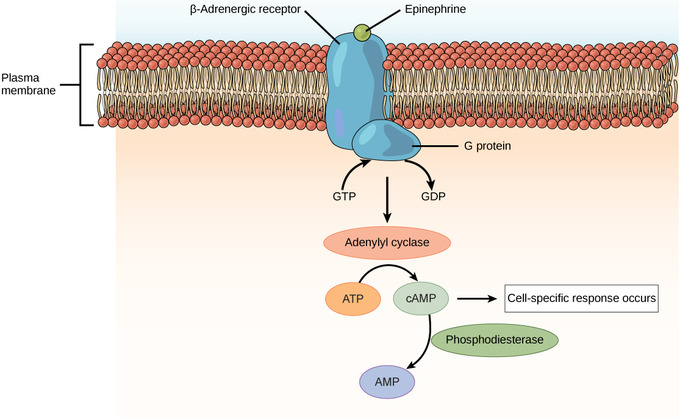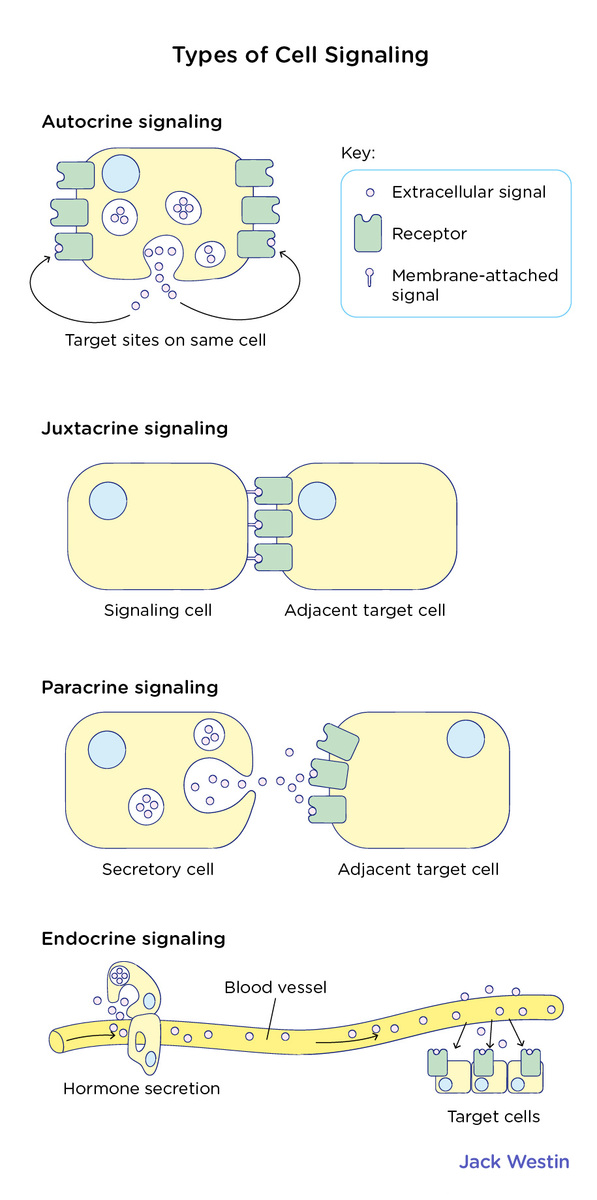What is mechanism of hormone action?
Hormones mediate changes in target cells by binding to specific hormone receptors. In this way, even though hormones circulate throughout the body and come into contact with many different cell types, they only affect cells that possess the necessary receptors. Receptors for a specific hormone may be found on many different cells or may be limited to a small number of specialized cells.
The hormone binds to the receptor protein, resulting in the activation of a signal transduction mechanism that ultimately leads to cell type-specific responses. Receptor binding alters cellular activity, resulting in an increase or decrease in normal body processes. Depending on the location of the protein receptor on the target cell and the chemical structure of the hormone, hormones can mediate changes directly by binding to intracellular hormone receptors and modulating gene transcription, or indirectly by binding to cell surface receptors and stimulating signaling pathways.
Lipid-soluble hormones such as steroid hormones diffuse across the lipid bilayer membranes of the endocrine cell. Once outside the cell, they bind to transport proteins that keep them soluble in the bloodstream. At the target cell, the hormones are released from the carrier protein and diffuse across the lipid bilayer of the plasma membrane of the target cells. They then adhere to intracellular receptors residing in the cytoplasm or in the nucleus. The cell signaling pathways induced by the steroid hormones regulate specific genes within the cell’s DNA. The hormones and receptor complex act as transcription regulators by increasing or decreasing the synthesis of mRNA molecules from particular genes. This, in turn, determines the amount of corresponding protein that is synthesized from this RNA; this is known as altering gene expression. This protein can be used either to change the structure of the cell or to produce enzymes that catalyze chemical reactions. In this way, the steroid hormone regulates specific cell processes. Other lipid-soluble hormones that are not steroid hormones, such as vitamin D and thyroxine, have receptors located in the nucleus. The hormones diffuse across both the plasma membrane and the nuclear envelope, then bind to receptors in the nucleus. The hormone-receptor complex stimulates transcription of specific genes in the same way that steroid hormones do.
Amino acid-derived hormones and polypeptide hormones are not lipid-derived (lipid-soluble or fat-soluble); therefore, they cannot diffuse through the plasma membrane of cells. Lipid-insoluble hormones bind to receptors on the outer surface of the plasma membrane, via plasma membrane hormone receptors. When a hormone binds to its membrane receptor, a G protein that is associated with the receptor is activated. G proteins are proteins separate from receptors that are found in the cell membrane. The activated G protein, in turn, activates a membrane-bound enzyme called adenylyl cyclase. Adenylyl cyclase catalyzes the conversion of ATP to cAMP. cAMP, in turn, enables a group of proteins called protein kinases, which transfer a phosphate group from ATP to a substrate molecule in a process called phosphorylation. The phosphorylation of a substrate molecule changes its structural orientation, thereby activating it. These activated molecules can then mediate changes in cellular processes. The hormone that initiates the signaling pathway is called a first messenger, which enables a second messenger in the cytoplasm.


• Lipid -soluble hormones are able to diffuse directly across the membranes of both the endocrine cell where they are produced and that of the target cell, as the cell membranes are made of a lipid bilayer.
• Amino acid-derived hormones and polypeptide hormones are not lipid-derived (lipid-soluble or fat-soluble); therefore, they cannot diffuse through the plasma membrane of cells.
• These hormones can bind to receptors that are located either in the cytoplasm of the cell or within the nucleus of the cell.
• When these hormones bind to their receptors, this signals the cell to synthesize more or less mRNA from a gene or genes, which then results in more or less protein being created from those mRNA molecules.
• The increase or decrease in protein production can alter the cell structurally or alter how and when it catalyzes chemical reactions.
• When a lipid (fat) insoluble hormone binds to a plasma membrane hormone receptor, this triggers specific actions inside the cell that alter the cell’s activities, such as gene expression.
• Because the first event in this sequence is the binding of the hormone to the plasma membrane receptor, the hormone is called the “first messenger”, while the molecule that is activated within the cell and carries out intracellular change is called the ” second messenger “.
• In many cases, a hormone binding to a plasma membrane receptor activates a special kind of protein called a G protein, which in turn activates an enzyme that generates cAMP, a second messenger.
• cAMP activates another group of proteins called protein kinases, which can change the structure of other molecules by adding a phosphate group to them; these activated molecules can then affect changes within the cell.
gene expression: the transcription and translation of a gene into messenger RNA and, thus, into a protein
transcription: the synthesis of RNA under the direction of DNA
steroid: a class of organic compounds having a structure of 17 carbon atoms arranged in four rings; they are lipids and occur naturally as sterols, bile acids, adrenal and sex hormones, and some vitamins
second messenger: any substance used to transmit a signal within a cell, especially one which triggers a cascade of events by activating cellular components
cyclic adenosine monophosphate: cAMP, a second messenger derived from ATP that is involved in the activation of protein kinases and regulates the effects of adrenaline
G protein: any of a class of proteins, found in cell membranes, that pass signals between hormone receptors and effector enzymes
water-soluble hormone: A lipophobic hormone that binds to a receptor on, or within, the plasma membrane, to initiate an intracellular signaling cascade
lipid-soluble hormone: A lipophilic hormone that passes through the plasma membrane of a cell, binds to an intracellular receptor and changes gene expression
intracellular: inside the cell
adenylyl cyclase: an enzyme which catalyzes the cyclization of adenosine triphosphate (ATP) into cyclic adenosine monophosphate (cAMP)
protein kinases: are enzymes that regulate the biological activity of proteins by phosphorylation of amino acids
phosphorylation: a biochemical process that involves the addition of phosphate